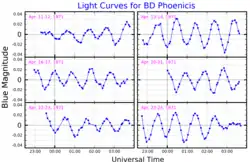| Observation data Epoch J2000 Equinox J2000 | |
|---|---|
| Constellation | Phoenix |
| Right ascension | 01h 50m 54.44s[2] |
| Declination | −50° 12′ 22.09″[2] |
| Apparent magnitude (V) | 5.90 – 5.94[3] |
| Characteristics | |
| Spectral type | A1Va λ Boo[4] |
| Variable type | δ Scuti[3] |
| Astrometry | |
| Radial velocity (Rv) | 3.0[5] km/s |
| Proper motion (μ) | RA: -47.85[2] mas/yr Dec.: -3.70[2] mas/yr |
| Parallax (π) | 12.7260 ± 0.0447 mas[2] |
| Distance | 256.3 ± 0.9 ly (78.6 ± 0.3 pc) |
| Absolute magnitude (MV) | 1.5 ± 0.1[1] |
| Details | |
| Mass | 2.02 ± 0.04[1] M☉ |
| Luminosity | 20.5 ± 0.34[6] L☉ |
| Surface gravity (log g) | 3.91 ± 0.08[1] cgs |
| Temperature | 7,818 ± 38[6] K |
| Rotational velocity (v sin i) | 120 ± 5 [1] km/s |
| Age | 813+38 −89[1] Myr |
| Other designations | |
| Database references | |
| SIMBAD | data |
BD Phoenicis is a variable star in the constellation of Phoenix. From parallax measurements by the Gaia spacecraft, it is located at a distance of 256 light-years (78 parsecs) from Earth.[2] Its absolute magnitude is calculated at 1.5.[1]
Description
BD Phoenicis is a Lambda Boötis star, an uncommon type of peculiar stars that have very low abundances of iron-peak elements. In particular, BD Phoenicis has near-solar carbon and oxygen content, but its iron abundance is only 4% the solar value.[1] BD Phoenicis is also a pulsating variable of Delta Scuti type, varying its apparent magnitude between 5.90 and 5.94.[3] A study of its light curve detected seven pulsation periods that range from 50 to 84 minutes, the strongest one having a period of 57 minutes and an amplitude of 9 milli-magnitudes. Pulsations are common among Lambda Boötis star and seem to be more common than on normal main sequence stars of the same spectral type.[1]
BD Phoenicis is an A-type main-sequence star with a spectral type of A1Va.[4] Stellar evolution models indicate it has about double the solar mass and an age of about 800 million years, having completed 83% of its main sequence lifetime.[1] It is radiating 21 times the Sun's luminosity from its photosphere at an effective temperature of 7800 K.[6] BD Phoenicis has a composite spectra that indicates it is a binary star, but nothing is known about the companion.[8][6]
Observations by the Herschel Space Observatory have detected an infrared excess from BD Phoenicis, indicating that there is a debris disk in the system. By modeling the emission as a black body, it is estimated that the dust has a temperature of 55±2 K and is at a distance of 118±10 au from the star. The existence of debris disks is possibly related to the Lambda Boötis phenomenon.[6]
References
- 1 2 3 4 5 6 7 8 9 10 Koen, C.; Paunzen, E.; Van Wyk, F.; Marang, F.; Chernyshova, I. V.; Andrievsky, S. M. (2003). "The pulsational characteristics of the λ Bootis type star BD Phe (HD 11413)". Monthly Notices of the Royal Astronomical Society. 338 (4): 931. Bibcode:2003MNRAS.338..931K. doi:10.1046/j.1365-8711.2003.06149.x.
- 1 2 3 4 5 6 Brown, A. G. A.; et al. (Gaia collaboration) (August 2018). "Gaia Data Release 2: Summary of the contents and survey properties". Astronomy & Astrophysics. 616. A1. arXiv:1804.09365. Bibcode:2018A&A...616A...1G. doi:10.1051/0004-6361/201833051. Gaia DR2 record for this source at VizieR.
- 1 2 3 Samus', N. N; Kazarovets, E. V; Durlevich, O. V; Kireeva, N. N; Pastukhova, E. N (2017), "General catalogue of variable stars: Version GCVS 5.1", Astronomy Reports, 61 (1): 80, Bibcode:2017ARep...61...80S, doi:10.1134/S1063772917010085, S2CID 125853869.
- 1 2 Gray, R. O.; Garrison, R. F. (1987). "The Early A-Type Stars: Refined MK Classification, Confrontation with Stroemgren Photometry, and the Effects of Rotation". The Astrophysical Journal Supplement Series. 65: 581. Bibcode:1987ApJS...65..581G. doi:10.1086/191237.
- ↑ Gontcharov, G. A. (November 2006), "Pulkovo Compilation of Radial Velocities for 35495 Hipparcos stars in a common system", Astronomy Letters, 32 (11): 759–771, arXiv:1606.08053, Bibcode:2006AstL...32..759G, doi:10.1134/S1063773706110065, S2CID 119231169.
- 1 2 3 4 5 Draper, Z. H.; Matthews, B. C.; Kennedy, G. M.; Wyatt, M. C.; Venn, K. A.; Sibthorpe, B. (2016). "IR excesses around nearby Lambda Boo stars are caused by debris discs rather than ISM bow waves". Monthly Notices of the Royal Astronomical Society. 456 (1): 459. arXiv:1511.05919. Bibcode:2016MNRAS.456..459D. doi:10.1093/mnras/stv2696. S2CID 118343020.
- ↑ "BD Phe". SIMBAD. Centre de données astronomiques de Strasbourg. Retrieved 31 January 2019.
- ↑ Faraggiana, R.; Bonifacio, P.; Caffau, E.; Gerbaldi, M.; Nonino, M. (2004). "λ Bootis stars with composite spectra". Astronomy and Astrophysics. 425 (2): 615–626. arXiv:astro-ph/0406265. Bibcode:2004A&A...425..615F. doi:10.1051/0004-6361:20040216. S2CID 117998682.
